Sam does his school homework in a room near the top of the lighthouse - not many children of his age have a bedroom and a games room and a homework room! Like all lighthouses the lower rooms have only very small windows or none at all, but near the top the windows can be bigger, and in his homework room he has one window (triple-glazed of course), looking out to sea, which is nearly two metres wide. His desk is by this window, and when he is sitting at it he can see everything in the coloured area as far as the horizon (where the sea meets the sky), which at the height of his homework room is about 22 km away. He cannot see anything outside the lighthouse to the left or right of this coloured area - the lighthouse walls are in the way!
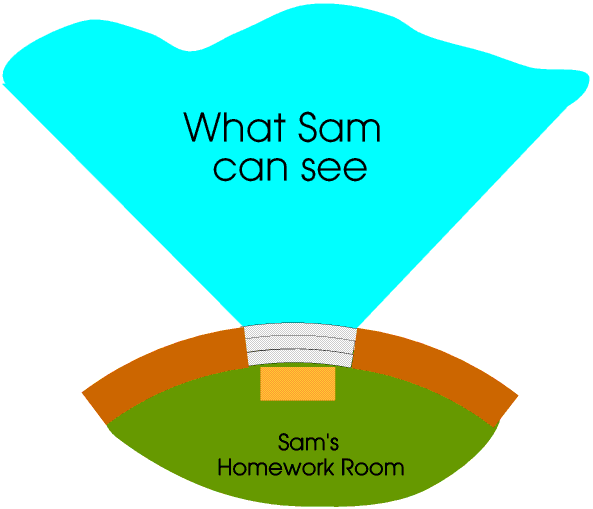

The lighthouse had once been used as a weather station, and there are still old weather balloons and cylinders of balloon gas in some of the store rooms. Sam and his brother and sister sometimes get them out for birthday parties.
For her birthday this year Natasha blows up a weather balloon until it is two metres across. After the party she lets it go, and it drifts across Sam’s window, about 10 m away.
Sam and his friends watch it from his homework room. At a distance of ten metres from the window their field of vision is about 20 m, so the balloon fills about 10% of it.

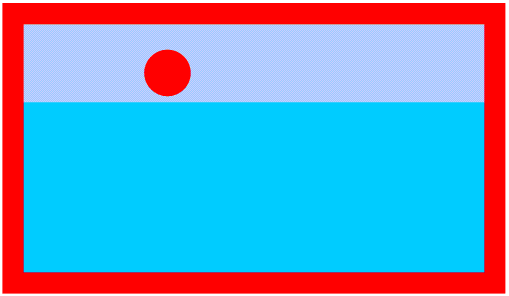
It is quite a calm day with a wind speed of about 7 km/h, so it will take the balloon about ten seconds to blow across the window.
During the day there are usually lots of ships and boats in the sea near the lighthouse and one day some of Sam’s friends are going out in their Uncle’s yacht - it is about 30 m long and can travel at 15 knots (about 28 km/h). Sam is looking out for them - when Sam sees them the yacht is about one kilometre away from the lighthouse. At this distance Sam’s field of view is about 2 km so the yacht fills about 1.5% of it. This is what he sees.
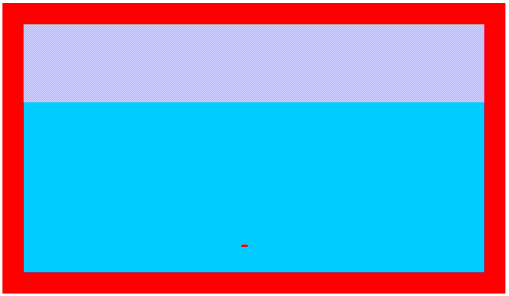
It will take the yacht a little over four minutes to pass right across Sam’s window.
One fine summer’s afternoon Sam sees a tiny speck very near the horizon. He is not certain what it is so he gets out his telescope. Not the astronomical telescope he uses for looking at the stars, that is on a special platform at the top of the lighthouse, where he can see the whole of the sky, and is far too big and heavy for him to carry down the narrow lighthouse stairs, but a much smaller ordinary one. Through this telescope he can see that the tiny speck is a very large aircraft carrier. Being on the coast the local newspaper web site gives details of all shipping movements in the area, and Sam uses it to discover that the nuclear powered aircraft carrier USS Nimitz is passing nearby today. This aircraft carrier is 330 m long and has a top speed of 35 knots (about 65 km/h). At the height of his homework room the horizon is 22 km away and his field of view at this distance is therefore 44 km, so the aircraft carrier fills 0.75% of it. This is what he sees.

Even at 35 knots it would take the aircraft carrier more than forty minutes to pass across his window from one side to the other.
This gives him plenty of time to take photographs, even going up to the roof to use his astronomical telescope.
When his friends next come round he shows them his photographs. He explains that the further away an object is the smaller it looks and the more slowly it moves, like the balloon, the yacht and the aircraft carrier. The Sun and Moon and Planets are, in astronomical terms, quite close to us and we can see them as discs and watch them move. But if we make a model of the Solar System with the Sun the size of a football, the Earth is 37 paces from the Sun, but it would take us several years to walk to our next nearest star!
The stars are actually enormous and moving at enormous speeds, but they are so far from the Earth that, seen from the Earth without a telescope, they appear to us as just points of light, and move so slowly that they have barely moved over the past thirty thousand years: seen from the Earth the stars appear to be in almost the same positions that they were in when people first started drawing pictures of what they saw in the sky. (But some stars have changed their brightness.)
Many 21st century children have difficulty with this, because they have never actually watched the stars for themselves, but they have often seen animations of black holes forming and galaxies colliding on television: millions of years in a few seconds.

In the 21st century more than half the population of the whole world live in large cities, and to very many people today night is just when you turn the lights on. Because of light pollution very few 21st century children, not even Sam, have ever experienced, or will ever experience, the Night Sky as it would have been experienced by everyone in the world, every night of the year, forty thousand, or four thousand, or even four hundred years ago.
The lighthouse is several kilometres from the nearest large town so on a moonless night in the winter the sky can be quite dark. Sam’s Granddad lives in an isolated farmhouse in the middle of the special Dark Sky area in the the Northumberland National Park, and Sam usually stays with him during the Autumn Half Term holiday: he does not want to go home afterwards! But our ancestors did not need to go home after being under the Dark Sky, because they were already there: home was a village in the middle of a space under a vast black dome, stretching from horizon to horizon, and studded with thousands of tiny lights, what they called stars.
From the surface of the Earth without a telescope the only thing we can actually measure are the angles between the stars and the horizon and the angles between the stars. They did not have telescopes but they did have sighting tubes to measure these angles.
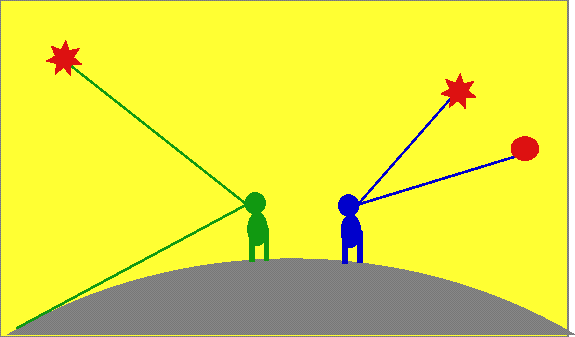
A sighting tube is a long tube which you can look through and align very accurately on a star, and then measure the angle you have to turn it through so that it is aligned on a different star, or the same star an hour or a day or a month or a year later.
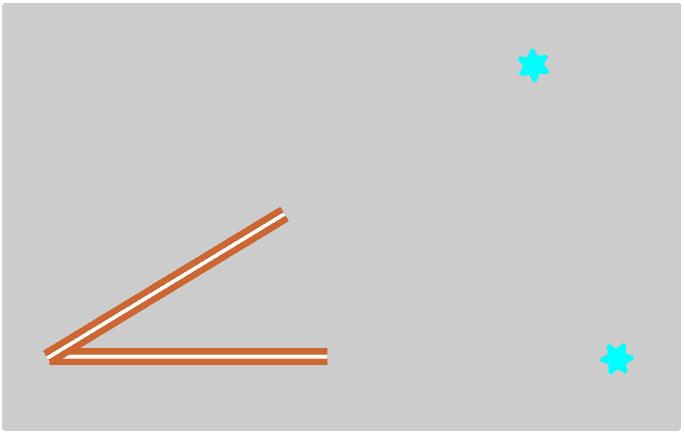
The early astronomers made and wrote down stunningly accurate measurements of these angular measurements, some of which still exist today, thousands of years later. These measurements allowed them to show that during each night the angle between each star and the horizon changed - each star moved right across the sky - but (with only seven exceptions) the angles between the stars did not change. From this they reasoned that all the stars, except the seven special stars, were fixed to the dome - it was the whole dome that was moving. The stars that were fixed to the dome they called the fixed stars and the seven special stars that were not fixed to the dome they called the moving stars. They went on to reason that the dome they saw was actually the top half of a huge sphere - the Celestial Sphere.
On a really dark night without a telescope you can see about five thousand stars, far too many for them all to be given names, instead the ancient astronomers named the patterns they made: these are the constellations: Hercules, Lyra, Orion and of course, Aries, Leo, Pisces etc. The constellations are described on another Page.
You can buy a “Celestial Sphere”, like an ordinary globe except that it shows the constellations rather than the continents and oceans, and of course Sam has one.
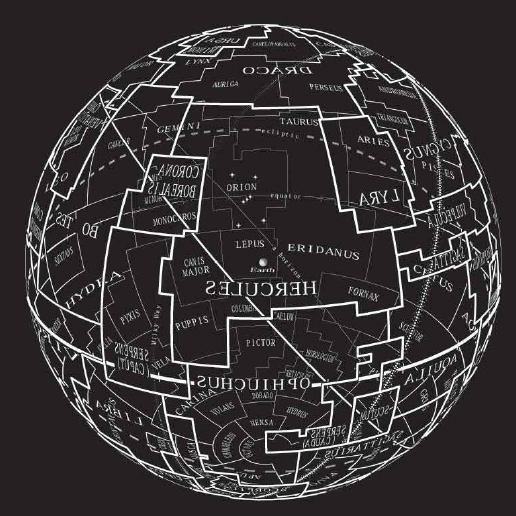
His is made of see-through plastic with the Earth in the middle and the constellations printed as though on the inside to make it more like the real thing. The North Celestial Pole is above the Earth’s North Pole, and similarly the South Celestial Pole and the Celestial Equator.
The star we call Polaris, or the Pole Star, is very close to the Celestial North Pole, so as the Earth rotates on its axis all the stars appear to rotate about Polaris.
The circle going right round the sphere but at an angle to the celestial equator is the ecliptic - this is described on its own Page.
Today of course we have all seen pictures taken by the Hubble Telescope so we know that the Universe is not really like this. Four thousand years ago many Wise Men had also realised that the Celestial Sphere was not real, it was just a very simple model to explain to ordinary people what they saw in the Night Sky, one that is as useful today as it has ever been. Only if you are using a very very powerful telescope, one costing millions of pounds, will you ever see the fixed stars as anything other than points of light or be able to measure their movement or say how far away they are.
Today Wise People (even teachers!) are still making models to explain complex ideas to ordinary people: we call them computer simulations, and we watch cgi (computer generated imagery) on our tablets and phones and tvs every day. But we are no different from our ancestors of four hundred, or four thousand, years ago: we can still get muddled up (or even be deliberately misled) about what is real and what is not: many children of Sam’s age know the Rules of Quiddich better than they know the Rules of cricket!

To the ancient people anything in the sky was a star. The fixed stars made up the constellations, and the Sun, Moon, Mercury, Venus, Mars, Jupiter and Saturn were the moving (wandering) stars: they wandered through the constellations, from Aries to Taurus to Gemini etc. - this is discussed more fully on another Page.
Our word planet comes from the Greek word for wanderer, although today we use it to mean something going round the Sun, so the Sun and Moon are not planets but the Earth is, and we have added Uranus and Neptune. Mercury, Venus, Mars, Jupiter and Saturn are bright objects in the sky but Uranus is only just visible without a telescope and is so far from the Sun that it moves through the constellations so slowly that was not identified as a planet rather than a star until 1781, and Neptune can never be seen without a telescope.© Barry Gray January 2022